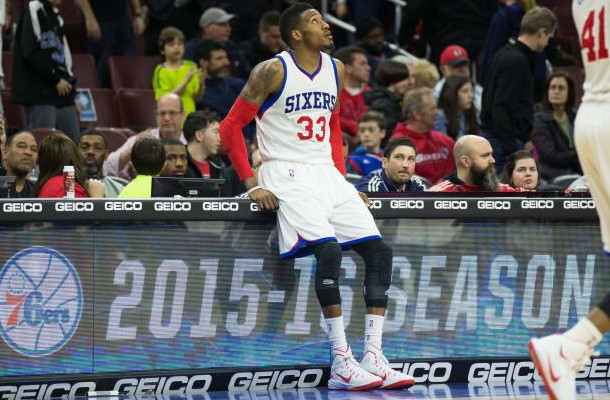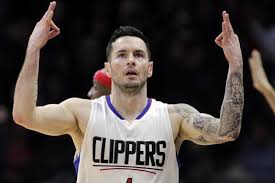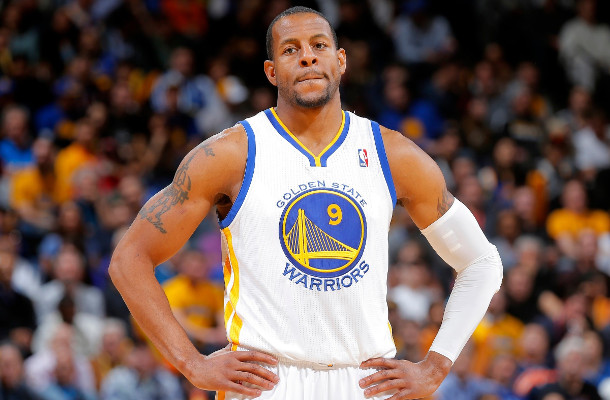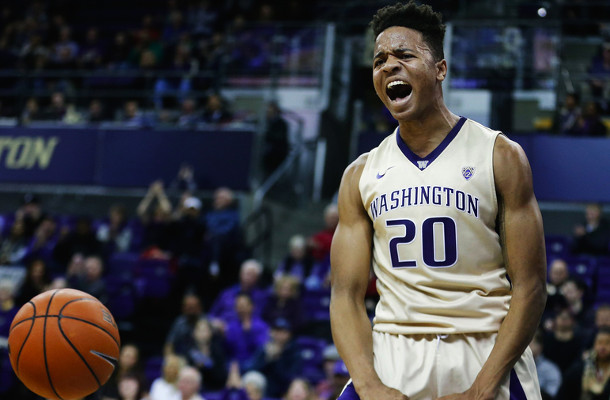Pursuing Kyle Lowry, extending Robert Covington, and the Sixers cap situation
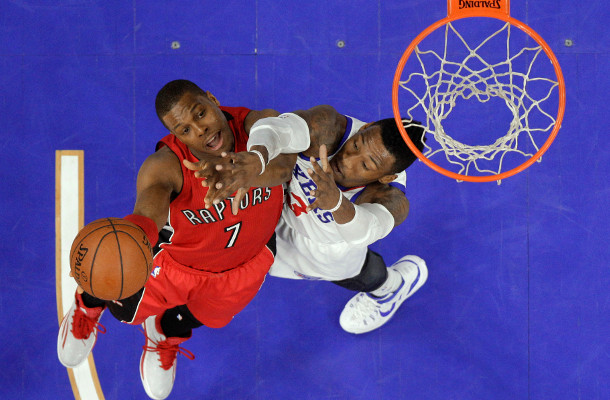
The question of whether the 76ers should pursue Kyle Lowry in free agency has been a source of debate Philadelphia of late, in large part because Lowry announced his intention to opt out of the final year of his contract, which would make him a free agent on July 1st.
The actual impact of this announcement is virtually meaningless, if for no other reason than anybody who gave the situation an even passing thought knew Lowry would do so. Lowry is on the final year of the 4 year, $48 million contract he signed in the summer of 2014, when at that time he had just had a career year, at the age of 28, with averages of 17.9 points, 7.4 assists, and 4.7 rebounds per game.
Lowry’s case was unique in how late he peaked. Heading into that contract year Lowry had averages of just 10.6 points, 3.7 rebounds, and 5.0 assists per game, and had averaged just 11.6 points, 4.7 rebounds, and 6.4 assists the previous season. Whether or not the new and improved Lowry was the one you could count on going forward was still in question, and this depressed his value on the market.
Because Lowry continued to improve so deep into his career his contract became one of the better contracts in the NBA, drastically underpaid under the previous CBA and downright criminal when the cap jumped as a result of the new national television deals. Lowry’s new contract will likely start around $35 million for 2017-18. Opting out of his $12 million was the most obvious decision in the NBA.
More important than Lowry’s announcement are the persistent rumors that the Sixers will have interest in Lowry when he does in fact become an unrestricted free agent, rumors in his interest in coming home, and of the relationship between Bryan Colangelo and the point guard who almost single-handedly saved his reputation in Toronto. Whether or not the Raptors would offer him their version of the max (~5 years, $200+ million), and whether he would give that up to accept the Sixers offer, which would be $50 million or so less, is another discussion. This question is simpler: should the Sixers pursue Lowry?
The 31-year-old Lowry being on another timeline than the Sixers is a very real concern. Lowry is likely to begin his decline as an NBA player during the course of this contract, a span in which Joel Embiid and Ben Simmons are just beginning their ascension. There’s also the fact that there are a handful of highly touted point guard prospects available in a strong draft class the Sixers could have two top-7 picks in.
The desire, outside of the Sixers’ desire to improve quickly, is peculiar. There are two real justifications I can see: the Sixers’ young core “learning how to win” and “experiencing the playoffs”, and using Lowry to help catapult the Sixers into NBA legitimacy in order to attract another star through trade and/or free agency.
The “learning how to win” argument is one we’ll shelve for another time. I think there is value to be had in playing competitive basketball deep into April and May, but there are better ways to do that than to commit to a point guard before you really figure out how to deploy Ben Simmons in the half court. There’s almost this sense that if the Sixers don’t give all their money to the first big name free agent who will have an honest to goodness sitdown with them, then they’re kicking the can down the road. Calm down and jump when you’re in a position of strength, and that comes when you have the full read on what to do with Ben Simmons long term.
Basically, there are better times to go all-in to push for the playoffs.
No, in order to pursue Lowry, there has to be the hope that he can legitimize the team into a force capable of attracting more star talent. That Lowry + Simmons + Embiid + Covington + others can get the Sixers to 45 wins, a playoff appearance, and become a legitimate draw for free agents next year, or to increase the chances that a star acquired via trade will stay. To answer that question, we have to really look at the Sixers’ salary cap situation.
Sixers 2017-18 salary cap overview:
Salary cap projection: $101,000,000
Guaranteed salaries: $36,595,973*
Likely options / non-guaranteed salary picked up: $4,519,994**
Filler contracts: $5,090,040***
That totals $46,206,007 in likely salary commitments, leaving roughly $54.8 million in cap space left.
* Guaranteed contracts / options already picked up: Jerryd Bayless, $9,000,000. Gerald Henderson, $1,000,000. Ben Simmons, $6,168,840. Joel Embiid, $6,100,266. Jahlil Okafor, $4,995,120. Nik Stauskas, $3,807,147. Tibor Pleiss, $500,000. Dario Saric, $2,422,560. Justin Anderson, $1,579,440. Timothe Luwawu-Cabarrot, $1,386,600).
** Likely options / non-guaranteed $ to be paid: Robert Covington, $1,577,230. Richaun Holmes, $1,471,382. T.J. McConnell, $1,471,382.
*** Filler contracts: 120% of the rookie scale for the #4 pick in the 2017 draft, the most likely outcome. This could increase if the Sixers are lucky enough to get the Lakers pick as well and/or move up in the lottery.
Robert Covington extension
One big use of this cap space could be a new contract for Robert Covington.
We would be talking about both a renegotiation of Covington’s existing 2017-18 season and also an extension beyond next year. Because the Sixers are so far under the salary cap, and because Covington is so underpaid and isn’t going to command a max contract, there might be a middle ground to be had where Covington can get his money, largely in the form of upfront money this year, but the impact on future years minimized as much as possible.
A couple of key notes:
* In order to renegotiate and extend Covington the team has to wait until the third year anniversary of his current contract. That was signed on November 15th, 2014, so he is not eligible for a renegotiation until November 15th, 2017.
* Because the Sixers have space for a maximum salary contract, the Sixers could theoretically renegotiate Covington’s 2017-18 salary to the max.
* However, the first year of the extension (2018-19) can only drop 40% from the renegotiated year. So you can’t, say, offer Covington $25 million in 2017-18 then $5 million per year after that.
* It used to be that renegotiation / extensions could only be for 4 years total, which includes the renegotiated year(s). That’s been increased to 5. In Covington’s case, that means you can renegotiate his one remaining season (2017-18), then offer him a 4 year extension.
A figure frequently thrown out for Covington is in the $15 million per year range. That makes a renegotiate + extend contract like this possible:
– 2017-18: $20 million
– 2018-19: $12 million
– 2019-20: $11.1 million
– 2020-21: $10.1 million
– 2021-22: $9.2 million
(After the 40% drop from the renegotiated year to the first year of the new extension, subsequent years can rise or fall under the same per-year changes as a new contract would).
This kind of de-escalating renegotiate-and-extend deals aren’t common in the NBA, in large part because when teams have cap space, they usually want to spend it to add more talent. This would typically be the case for the Sixers, too, as normally this would be one last final hurrah to make a splash in free agency before Embiid starts making major money. You don’t typically say “you know what, Covington is set to make $1.5 million this year, let’s bump that up to $20 million rather than pursue more pieces to add to this team”.
But nothing about this situation is normal. As we explained above, the Sixers will have upwards of $54.8 million in cap space. Even after bumping Covington up to $20 million in a renegotiated contract, they’d still have room to offer a max contract. And dropping Covington’s new contract down to a starting point of $12 million, and dropping from there, makes the new deal a bargain.
From Covington’s perspective, he’s getting $62.4 million over a 5 year span, from 2017-18 through 2021-22. This means that, with the $1.58 million contract he’s owed for next year, he’d have to think he can do better than a 4 year, $60.82 million contract as a free agent in the summer of 2018. AND he’d have to be willing to turn away that immediate money and live with the risk of injury.
Obviously, this baseline might change, and it’s just a hypothetical. Maybe the Sixers don’t want to commit $42.4 million to Covington between 2018-19 and 2021-22. Maybe Covington thinks he can get a bigger deal than 4 years, $60+ million as an unrestricted free agent next summer, and he’d be willing to live with the risk.
But there’s compelling reasons for both sides to explore a renegotiate-and-extend, especially for a team like the 76ers who are unlikely to use all their money this summer. The cost of getting Covington on a below-market, long-term deal is just sacrificing money in 2017-18 you were going to have to spend to reach the salary floor anyway, unless you have unrealistic aspirations to attract *two* max free agents this summer.
(There is one possible reason to wait until Covington becomes a free agent before signing him to a new contract, even if you hope to keep him around long-term: his minuscule cap hold in the summer of 2018. That’s obviously very risky, though, as you risk losing him for nothing, especially if you disenfranchise him by not discussing a renegotiation this year. More on that below).
The reason to get that out of the way is to get a clearer picture on the salary cap situation in the summer of 2018, to loop us back to the question of whether it’s realistic to sign Kyle Lowry *and* make yourself a free agent destination in 2018.
Sixers 2018-19 salary cap overview:
Salary cap projection: $102,000,000
Guaranteed salaries: $57,693,416*
Likely options picked up: $18,420,663**
Qualifying Offers / cap holds: $15,250,665***
Filler: $13,741,680****
Total: $105,106,424
Cap space: -$3,106,424
* Gtd contracts: Kyle Lowry, $37,117,500. Jerryd Bayless, $8,575,916. Robert Covington, $12,000,000.
** Options: Ben Simmons, $6,434,520. Jahlil Okafor, $6,313,832. Dario Saric, $2,526,840. Timothe Luwawu-Cabarrot, $1,544,951. Richaun Holmes, $1,600,520.
*** Cap hold: Joel Embiid, $15,250,665.
**** Filler: 120% of 2nd year rookie scale for #4 pick in 2017 draft, $6,041,520. 120% of 1st year rookie scale for #5 pick in 2018 draft, acquired from Lakers, $5,262,480. 120% of 1st year rookie scale for #17 pick in the draft, Sixers own pick, $2,437,680.
(Note: I used the 17th pick because, ostensibly, Lowry would be signed because you think he can help get you into the playoffs and make you a destination. That’s the crux of this whole argument.)
(Note: Before Embiid signs a new contract, he would have the $15.2 million cap hold listed above. So, if the Sixers were looking to maximize their cap space, they would come to a verbal agreement with Embiid, sign an outside free agent, *then* officially sign Embiid to his new deal, assuming the first year on his new contract is greater than $15.2 million).
The situation isn’t quite as dire as that makes it out to be. There are options that could not be picked up (Okafor, although a trade before then seems more likely). Draft picks and/or players on rookie contracts could be traded, although the best case scenario of Fultz and his $8.3m 2nd year salary would eat into that. Heck, at $12 million and with a declining salary, Covington could be traded if you believe a 4th star could join in free agency to join your Embiid/Simmons/Lowry core. Perhaps you could even find a taker for Jerryd Bayless on the last year of his deal, although what he’s able to show over the next 12 months, both in terms of play and health, will play a big part in that equation.
So, if you’re willing to strip away just about everything outside of that core:
– Embiid ($15.3m) + Lowry ($37.1m) + Simmons ($6.4) + Dario ($2.5) = $61.3 million.
If the 2017 draft pick is a keeper that you’re unwilling to move on from this early, take another $6-$8.3m off that number, putting you right on the border of being able to offer a max deal despite having just 5 players under contract/cap hold. You’ll also lose another $10m or so when Embiid officially signs, either this fall via extension or in July 2018 with a new contract as a restricted free agent, putting you over the cap with just 5-6 players under contract.
(The cap hold to retain Covington’s bird rights next summer would only be 190% of his previous salary, or ~$3m. In theory, you could save $9m in cap space next summer by *not* pursuing a renegotiate and extend now. This would carry with it significant risk if you want Covington part of your long-term plans, however, as he would enter the 2018 free agency period as an unrestricted free agent, and you’d have a greatly diminished chance of getting him on a below-market deal for 2018-19+. It is an option to maximize 2018 cap space, though).
Not to mention how pricey that core gets when Simmons and Saric come up for new deals following the 2019-20 season.
This is one of the areas where Embiid’s delayed debut hurts you. In an ideal world, he would have established himself as a force in the league with 1-2 years left on his rookie scale contract. Instead, he’s extension eligible now but not yet played enough to really be an attraction in his own right, at least not for established stars. It shrinks the window considerably, even if we all have the utmost confidence he’ll be a factor in the league if he stays healthy.
Allocation of resources
There’s been a lot of talk about position-less basketball and about not having too many decision makers on the floor. I agree with that. I’ve made that argument, especially as it relates to Lonzo Ball, who might be best utilized off the ball in the half court (at least for stretches of play) while being able to space the floor, make quick decisions, and push the ball in transition.
Golden State is an example of “can’t have too much talent”. Again, I agree, but the key Golden State players are all elite off the ball. You might not be getting 100% of either Kevin Durant or Steph Curry in their current role and with their current touches, but you are getting the best in the NBA at the role you’re asking them to fill.
The Sixers pieces, on the other hand, wouldn’t be that. Kyle Lowry can shoot off the ball, but what makes him unique, what makes him worth $35m, is his talent with the ball in his hands as well. He’s a good off the ball shooter, but not elite, and if he’s playing an entirely off the ball role you could fill that cheaper. He obviously wouldn’t be playing entirely off the ball, but I’m making a point: how much he’s able to initiate is going to impact whether acquiring him makes sense.
This is even more true for Ben Simmons, who looked largely disengaged off the ball for LSU, doesn’t space the floor at all, and was at times a disinterested defender, especially when the offense wasn’t run through him. Again, you could make the case that Simmons would still be valuable in this role — as a playmaking defender, defensive rebounder, transition pusher who makes plays out of secondary action in the half court — but he’s not going to be the elite prospect you drafted #1 overall if you remove the ball from his hands too much.
The cost of acquisition is a very big point when discussing this. Adding a maximum salary contract in free agency isn’t something you have the chance to do very often, and its success will depend on the role the player will be placed into. Even more to the point, adding an elite, long-term controllable talent via the #1 pick in the draft is even more of a rare opportunity, and maximizing what made him unique is of utmost importance. That could be true of Ben Simmons, who you already have on your roster, and of Markelle Fultz, depending on luck on May 16th.
It’s one thing to add one more ball handler (that can also play off the ball) to the Ben Simmons/Joel Embiid/Dario Saric core, whether that’s through free agency or the draft. But adding two? I worry about wasting rare opportunities, about diminishing returns, and about whether those diminished returns alter the equation on whether imperfect players are still impact players.
Conclusion
So, is there a world where you can add Kyle Lowry and still have close to, if not at, maximum salary cap space next summer? There is, although you’d have to embrace a scorched earth roster building strategy to accomplish that, would have to be willing to move on from some assets you had hope for, and might need to find some teams willing to take on salary next summer to really get there. But thanks to the Sixers’ absurd flexibility and the still rising (albeit slower) salary cap, it is still in the cards, even if you have to get creative to do so.
Whether Lowry could help improve the team enough that they could be a destination for a potential star level player in free agency next summer, or whether the legitimacy Lowry brings (alongside the continued development and availability of Embiid and the debut of Simmons) would help convince a star you could potentially acquire via trade to stay long term, is where this strategy could get the most interesting. I’m not entirely sure what the probability of any of this happening is, but the sheer upside would be fascinating to think about.
In some sense, there’s a part of me that would respect the gumption and guts it would take to try this, if this was, in fact, even the longer-term plan the Sixers have in mind if and when they offer Lowry a contract this summer. Building the bench would be tough, especially as Simmons and Saric come up for new contracts following the 2019-20 season. But if you walk away with a core of Joel Embiid, Ben Simmons, Kyle Lowry, Jonathan Isaac, and a Paul George level player it may not matter, even as Lowry begins his inevitable decline. I also think there’s some argument to be made that how swift Embiid’s rise to being an impact player should make you, at the very least, re-evaluate your definition of the timeline the Sixers are on.
Still, the uncertainty with how to best maximize Ben Simmons gives me pause from recommending this. You’ll notice that there was almost no time spent discussing the quality of player Kyle Lowry is. He’s very, very good, and he would make the team much better in the short term. That’s not particularly up for debate in my mind. What is in question is the loss of flexibility, in Lowry’s age and remaining time as an impact player, and of the maximization of opportunities you don’t often get in this league.
My inclination would be to pursue a renegotiate-and-extend with Covington, to evaluate what you can reasonably project out of Ben Simmons in the half court, to draft the best player(s) available in the draft and not worry about their fit with Lowry, and to pounce in free agency or trade when you’re in a position of strength with respect to knowledge on how to best surround Simmons and Embiid to get the most out of their unique, and elite, talents.


